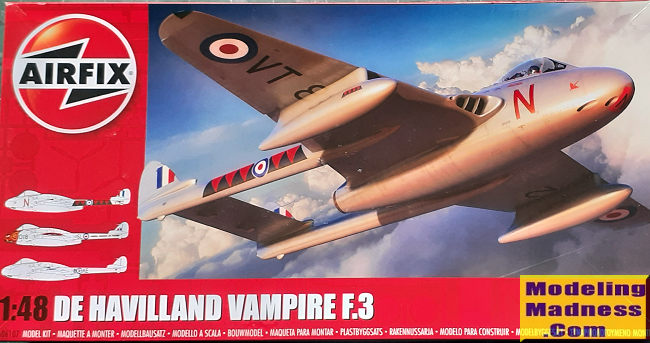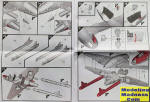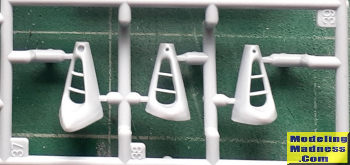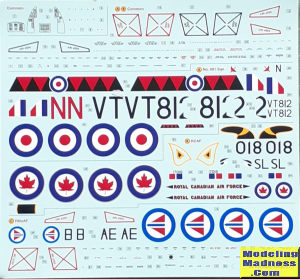
Airfix 1/48 Vampire F.3
| KIT #: | A06107 |
| PRICE: | $35.00 |
| DECALS: | Three options |
| REVIEWER: | John Summerford |
| NOTES: | Paint call-outs are only for Humbrol numbers |

| HISTORY |
Courtesy BAE systems
The success of the Gloster Meteor led to De Havilland Aircraft Company being approached to design and build an airframe for the Halford H1 turbojet engine (later to become the DH Goblin). Initially designated DH99 (named the ‘Spider Crab’), it was an all-metal design which was considered to be hugely experimental in its unorthodox arrangement of twin rear booms mounted behind a molded, egg-shaped wood/aluminum fuselage and one single engine. Further modifications resulted in the design re-designated as the DH100 Vampire.
The prototype DH100 Vampire (LZ548/G) was first flown on 20th September 1943 at Hatfield by Geoffrey R de Havilland (son of the founder), 6 months after the Meteor, due to delayed by engine availability.
The first production DH Vampire (F.1) was actually produced by the English Electric Company at Warton due to the production pressures and a lack of capacity at Hatfield. Despite finally arriving after the end of the Second World War, the DH Vampire was eagerly awaited and became the second British jet fighter to see service with the RAF. It was also given the honor of leading the VE - Day fly-past over London. It was the first RAF aircraft to be able to exceed 500.
The main production version was to be the DH Vampire FB.5 fighter bomber (a modified DH Vampire F.3) and this variant was also be the basis for many of the export versions. Separate night fighter and trainer models were produced as the DH113 Vampire NF and DH115 Vampire Trainer respectively.
A number of DH100 Vampires were also modified for shipboard use such as the De Havilland DH Sea Vampire and on 3rd December 1945, Captain Eric 'Winkle' Brown completed the first successful landing and take-off of a jet fighter from the Carrier HMS Ocean. Subsequently, it became the Royal Navy’s first jet fighter.
The type was very successful in the export market, providing many air forces with their first experience of jet fighter operations and around 30 air forces were ultimately to operate the type. Some fifty DH100 Vampire F1, F2 and FB variants were purchased by the Royal Australian Air Force in 1946 and, although the majority were built with Goblin engines, the second aircraft was actually built with a Rolls-Royce Nene power-plant.
By the time production finally ended, 3,269 Vampires had been built in England and a further 1,067 built under license abroad. The DH Vampire remained as a front-line fighter for the RAF until 1953, after which it was retained only in the pilot training and refresher role.
Elsewhere, the aircraft had surprisingly longevity with large numbers still in service in several air forces in the 1980s. The Swiss Air Force was the last Vampire user, retiring their sizeable fleet of DH Vampire FB.6s and T.55s from active service as late as 1990 It was finally retired from RAF service in 1966, being replaced by the Hawker Hunter and Gloster Javelin.
DH Vampire F.3 version had a production run of two prototypes and 202 airframes. It featured revised tail surfaces of a more ‘De Havilland’ shape; tailplane chord increased. Maximum weight increased to 11,970 lb. and flown 4 November 1946. 20 were exported to Norway and 86 aircraft sold to Canada.
| THE KIT |

The parts are well molded with crisp detail, no flash, and seams almost nonexistent. Wheel well detail is molded into the upper wing. The only flaw that I could detect is a sink mark in fillet at the trailing edge of the right wing and fuselage. There is just enough texture on the surface to soften the sheen of the plastic.
 The
engineering of this kit is fantastic! Included are two spars. The front spar
incorporates the first compressor face of the engine and the aft face of the
main landing gear wells with the aft spar having the engine turbine and hinge
plates for the flaps. The intakes are single pieces and have the vanes molded
in. Three come with the kit, the oddball for another version (the FB.9. Ed).
After looking at how the booms are keyed into place, their attachment is
foolproof. (Although, this fool has defeated other manufacturer’s efforts.)
The
engineering of this kit is fantastic! Included are two spars. The front spar
incorporates the first compressor face of the engine and the aft face of the
main landing gear wells with the aft spar having the engine turbine and hinge
plates for the flaps. The intakes are single pieces and have the vanes molded
in. Three come with the kit, the oddball for another version (the FB.9. Ed).
After looking at how the booms are keyed into place, their attachment is
foolproof. (Although, this fool has defeated other manufacturer’s efforts.)
Total parts count, including the clear parts is 124. Options are included for a seat for a pilot figure, or one without that has a harness molded in, two instrument panels, external underwing fuel tanks, and flaps posed completely down or up.
 Decals for
three options are found in the folds of the instructions. All three options are
for aircraft in museum collections. Depicted on cover is the first option, VT812
found at the RAF Museum, Hendon, United Kingdom. Option two is 442 “City of
Vancouver” at the Comox Airforce Museum, Comox, British Columbia, Canada and
sports a bat head motif on the nose. The third is P42408/AE-B found at the
Gardermoen Museum, Oslo, Norway. All have the primary color in High-Speed
Silver.
Decals for
three options are found in the folds of the instructions. All three options are
for aircraft in museum collections. Depicted on cover is the first option, VT812
found at the RAF Museum, Hendon, United Kingdom. Option two is 442 “City of
Vancouver” at the Comox Airforce Museum, Comox, British Columbia, Canada and
sports a bat head motif on the nose. The third is P42408/AE-B found at the
Gardermoen Museum, Oslo, Norway. All have the primary color in High-Speed
Silver.
The instructions are in a 16-page booklet. The first two pages cover a brief history in five languages and the usual cautions and symbol explanations. The next 10 pages illustrate assembly sequence starting at the lower wing/fuselage and continues over 87 steps. If the flaps are to modeled up, steps 39 through 52 can be skipped. Most of the steps show only one or two pieces added.
In the first step, attention is called out to a hole that should be drilled for part D19, that is installed in step 32, before the upper and lower wing/fuselage sections are mated. I think that part is an antenna and it sits off-center of the underwing roundel, so it would be far easier to install it after decaling. The other underwing roundel decal obscures a landing light, so one can either mask the lens, and cut the decal after it dries, or trim the decal before application.
Color call-outs for interior paints just list the Humbrol number, not the name of the color, while the names are given for the exterior colors.
| CONCLUSIONS |
The engineering of this kit is very well thought-out. Other than installing part D19 at the end of build, one should end up with a great model by following the instructions and should be a straight forward build out of the box. Look forward to other variants from Airfix in the coming years.
Back to the Previews Index Page
Back to the Previews Index Page